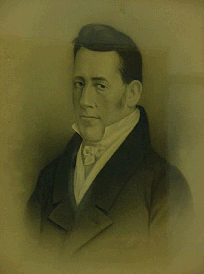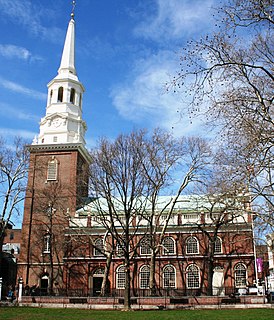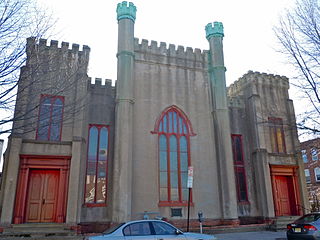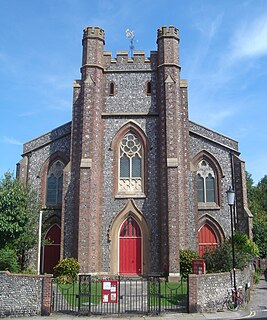
The Episcopal Church of Jerusalem and the Middle East is a province of the Anglican Communion. The primate of the church is called President Bishop and represents the Church at the international Anglican Communion Primates' Meetings. The Central Synod of the church is its deliberative and legislative organ.

Samuel Seabury was the first American Episcopal bishop, the second Presiding Bishop of the Episcopal Church in the United States of America, and the first Bishop of Connecticut. He was a leading Loyalist in New York City during the American Revolution and a known rival of Alexander Hamilton.

Samuel Paynter was an American merchant and politician from Drawbridge, in Broadkill Hundred, Sussex County, Delaware. He was a member of the Federalist Party, who served in the Delaware General Assembly and as Governor of Delaware.
The Anglican Diocese of Jerusalem is the Anglican presence in Israel, the Palestinian territories, Jordan, Syria and Lebanon; it is a part of the Episcopal Church in Jerusalem and the Middle East, and based at St. George's Cathedral, Jerusalem. The diocese covers 7,000 Anglicans, with 35 service institutions, 29 parishes, 1500 employees, 200 hospital beds and 6,000 students. Today, Anglicans constitute a large portion of Jerusalem's Christians.

The Diocese of Chichester is a Church of England diocese based in Chichester, covering Sussex. It was founded in 681 as the ancient Diocese of Selsey, which was based at Selsey Abbey, until the See was translated to Chichester in 1075. The cathedral is Chichester Cathedral and the diocesan bishop is the Bishop of Chichester. The diocese is in the Province of Canterbury.

St. James Episcopal Church, Mill Creek, also known as St. James Church or St. James Church, Stanton, is an historic Episcopal church located at 2106 St. James Church Road, in Stanton, Mill Creek Hundred, New Castle County near Wilmington, Delaware.

Christ Church is an Episcopal church in the Old City neighborhood of Philadelphia. Founded in 1695 as a parish of the Church of England, it played an integral role in the founding of the Protestant Episcopal Church in the United States. In 1785, its rector, William White, became the first Presiding Bishop of the Episcopal Church.

Established in 1703, St. Michael's Church in downtown Trenton, Mercer County, New Jersey, United States, is a founding parish of the Episcopal Diocese of New Jersey. Its present building located at 140 North Warren Street was built in 1747–1748, and was renovated in 1810 and 1847–1848. It was listed on the National Register of Historic Places on April 29, 1982 as St. Michael's Episcopal Church.

The Episcopal Diocese of San Diego is the diocese of the Episcopal Church in the United States of America with jurisdiction over San Diego County, Imperial County and part of Riverside County in California plus all of Yuma County in Arizona. It is in Province 8 and encompasses some 50 congregations. It was created in 1973 by splitting off from the Episcopal Diocese of Los Angeles. Its cathedral, St. Paul's Cathedral, is in San Diego. The diocesan offices are located in Ocean Beach at 2083 Sunset Cliffs Blvd., San Diego, CA 92107.

St. David's Episcopal Church, often known as St. David's at Radnor or, less often, as Old St. David's, is a parish of the Episcopal Church in the United States of America, founded in the early 18th century and named after the Patron Saint of Wales. A Book of Common Prayer, given as a gift to Lydia Leamy in 1854, refers to St. David's as "Radnor Church". It has grown to be the largest congregation in the Episcopal Diocese of Pennsylvania, with some 950 active families and 3,000 members. The original church building, built in 1715 and the subject of a Longfellow poem, still stands. It is in nearly the same condition as when it was built, several new buildings having been constructed to house the growing congregation. The adjacent graveyard is a part of the historic site. The church property is divided by the borders of three townships, in two counties, often causing confusion as to the church's location. The church office is located at 763 South Valley Forge Road in Wayne, Radnor Township, Delaware County, Pennsylvania.

The Episcopal Church (TEC) is a member church of the worldwide Anglican Communion and is based in the United States with additional dioceses elsewhere. It is a mainline Christian denomination divided into nine provinces. The presiding bishop of the Episcopal Church is Michael Bruce Curry, the first African-American bishop to serve in that position.

Old Trinity Church, also known as Trinity Church, Oxford, is a historic Episcopal church founded in 1698 in Oxford Township, Pennsylvania, which is now part of Philadelphia.

Old Christ Church, also known as Old Lightwood, is a historic Episcopal church near Laurel, Sussex County, Delaware. The 1772 church resembles its parent church, Green Hill Church of Stepney Parish in Wicomico County, Maryland, except that while Stepney was built in brick, Christ Church is of wood construction. Its weathered appearance gave rise to a nickname "Old Lightwood," although it now is painted barn red.
Richard Williams Morgan (c.1815-1889) was a Welsh Anglican priest and author, later the first Patriarch of the Ancient British Church.

The Church of St John sub Castro is an Anglican church in Lewes, the county town of East Sussex, England. It was built in 1839 on the site of an 11th-century Saxon church, and has been designated by English Heritage as a Grade II listed building. In the churchyard is a memorial to Finnish prisoners from the Crimean War who died while confined in Lewes Naval Prison; the memorial is also listed Grade II. The church continues to be active as a parish church in the diocese of Chichester.
Thomas Bowers (1660–1724) was an Anglican bishop of Chichester. The son of Mr. Richard Bowers, a draper of Shrewsbury, he was educated at Shrewsbury School and St. John's College, Cambridge.

St Andrew's Church is an Anglican parish church in the centre of Farnham, Surrey. It is a Grade I listed building and surviving parts of the structure date back to the Middle Ages. It in the archdeaconry of Surrey, in the Diocese of Guildford. The churchyard contains the grave of William Cobbett and there is a memorial to Augustus Toplady.
Jonathan Watson (1760–1808) was an Anglican clergyman who served in the Scottish Episcopal Church as the Bishop of Dunkeld from 1792 to 1808.
St. Luke's Episcopal Church is located at 615 Vermillion Street in historic downtown Hastings, Minnesota, United States.

The Church of St Mary the Virgin is a Grade II* listed Anglican church in the village of Glynde in East Sussex. It was built in the 1760s by Richard Trevor, bishop of Durham, whose family seat was the adjacent Glynde Place.














